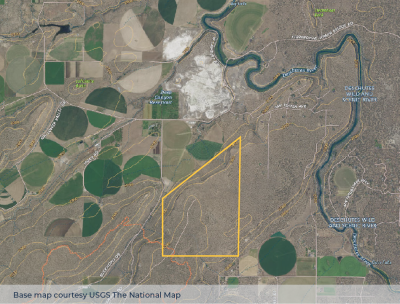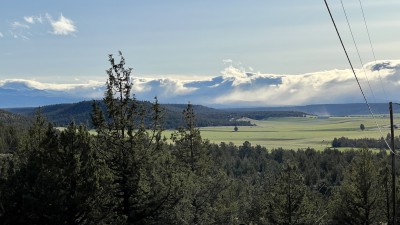By 1000 Friends of Oregon staff | 2.5-minute read
Earlier this year, the Oregon Court of Appeals issued a decision to prevent patchwork fracturing of agricultural land, a landmark victory for agricultural lands protections in Oregon.
The case, co-argued by 1000 Friends of Oregon, involved Deschutes County’s redesignation of 710 acres of rangeland as nonresource land and changing the the zoning from exclusive farm use to rural residential in order to allow 71 residential homesites at 10 acres each, a sprawling development in the middle of farmland.

The property is a typical tract of Oregon high-desert rangeland well-suited to ranching operations, with sagebrush and juniper dotting a ridge that stretches southwest from a hairpin bend in the Deschutes River. It sits in the Lower Bridge Valley, roughly five miles west of Terrebonne in Central Oregon, among active farm operations that leave semicircles of green across the land. (Though not part of the case, it is also in an area with high probability of burning in a wildfire.)
The court’s decision upheld a July 2023 ruling by the Land Use Board of Appeals that Deschutes County had violated state land use law in removing the rangeland tract from state agricultural lands protection. In reaching its decision, the court relied on 1000 Friends of Oregon’s argument that statewide planning Goal 3’s definition of agricultural land protects not only lands suitable for farming, but also lands whose protective zoning is necessary to permit farm practices on adjacent and nearby lands.

Andrew Mulkey and Blair Batson represented 1000 Friends of Oregon in the case, joining Central Oregon LandWatch, the Department of Land Conservation and Development, and local concerned parties.
“This win is important not only for the protection of this 710-acre tract of rangeland, but for the future protection of all Eastern Oregon rangeland and Oregon’s agricultural land in general,” says Batson. “Deschutes is one of several counties that have adopted a pattern of rezoning random patches of agricultural land to create islands of residential and commercial development in the middle of exclusive farm use zones. The counties rely on an applicant’s paid soils scientist to challenge the productivity of agricultural land without considering the impact of such spot zoning on the agricultural area as a whole.”

While 1000 Friends of Oregon and others work to stop these destructive case-by-case rezonings at the state level, the court has given Oregonians a powerful tool to use in local land use proceedings. Counties who have paid scant attention to the “necessary to permit farm practices” component of Goal 3’s agricultural lands definition will have a more difficult time avoiding its requirements with the court’s clarifying language.
More immediately, this area will remain a large, cohesive block for exclusive farm use, free from nearby nonfarm development’s interference with agricultural practices. And thanks to the precedent set in this case, similar at-risk agricultural lands in Deschutes County and Oregon’s 35 other counties will also be protected.
Resources: Decision
